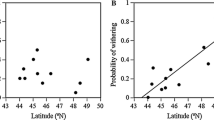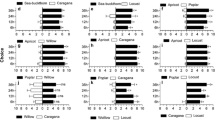Abstract
The slow growth/high mortality hypothesis predicts that herbivorous insects feeding on suboptimal host plants are subjected to higher predation mortality owing to the longer time spent in the vulnerable juvenile stages compared with conspecifics feeding on optimal plants. We tested this hypothesis for the willow-feeding leaf beetle Galerucella lineola raised on one suitable (Salix viminalis) and one unsuitable (S. dasyclados) willow species as well as on plants from an interspecific cross between the two species. Cohorts of larvae raised on caged plants (protected from enemies) and uncaged plants (exposed to enemies) were monitored daily throughout larval development in two consecutive years. Larvae raised on S. viminalis developed faster, grew larger and survived better than those raised on S. dasyclados. The suitability of the hybrid plants was intermediate to that of their parents. Our results strongly support the slow growth/high mortality hypothesis. In both years, total predation during the larval period was higher on S. dasyclados than on S. viminalis. Furthermore, the daily predation rate (i.e. the proportion of larvae preyed upon per day) was higher on S. dasyclados than on S. viminalis. When hybrid plants were included in the analysis total predation was positively correlated with both larval development time and daily predation rate. We suggest that high predation on beetles on low-quality plants is the combined result of their longer development time and elevated daily predation rate. The results are discussed in relation to the evolution of host plant selection and the paradox of sublethal plant defenses.
Similar content being viewed by others
References
Berenbaum MR, Zangerl AR (1993) Furanocoumarin metabolism in Papilio polyxenes: biochemistry, genetic variability, and ecological significance. Oecologia 95: 370–375
Bergelson JM, Lawton JH (1988) Does foliage damage influence predation on the insect herbivores of birch? Ecology 69: 434–445
Bernays EA, Chapman RF (1994) Host-plant selection by phytophagous insects. Chapman and Hall, New York
Bernays EA, Graham M (1988) On the evolution of host specificity in phytophagous arthropods. Ecology 69: 886–892
Boethel DJ, Eikenbary RD (eds) (1986) Interactions of plant resistance and parasitoids and predators of insects. Ellis Horwood, Chichester
Carter MC, Sutherland D, Dixon AFG (1984) Plant structure and the searching efficiency of coccinellid larvae. Oecologia 63: 394–397
Clancy KM, Price PW (1987) Rapid herbivore growth enhances enemy attack: Sublethal plant defenses remain a paradox. Ecology 68: 733–737
Damman H (1987) Leaf quality and enemy avoidance by larvae of a pyralid moth. Ecology 68: 88–97
Denno RF, Larsson S, Olmstead KL (1990) Role of enemy-free space and plant quality in host-plant selection by willow beetles. Ecology 71: 124–137
Denno RF, McClure MS (eds) (1983) Variable plants and heribvores in natural and managed systems. Academic Press, New York
Dicke M, Sabelis MW (1988) How plants obtain predatory mites as bodyguards. Neth J Zool 38: 148–165
Dicke M, Beek TA van, Posthumus MA, Ben Dom N, Bokhoven H van, Groot AE de (1990) Isolation and identification of volatile kairomone that affects acarine predator-prey interactions: involvement of host plant in its production. J Chem Ecol 16: 381–396
Evans HF (1976) The searching behaviour of Anthocoris confusus (Reuter) in relation to prey density and plant surface topography. Ecol Entomol 1: 163–169
Feeny P (1976) Plant apparency and chemical defense. In: Wallace JW, Mansell RL (eds) Biochemical interactions between plants and insects (Recent advances in phytochemistry, vol 10). Plenum, New York, pp 1–40
Fritz RS, Simms EL (eds) (1992) Plant resistance to herbivores and pathogens. Ecology, evolution, and genetics. University of Chicago Press, Chicago
Hare JD (1992) Effects of plant variation on herbivore natural enemy interactions. In: Fritz RS, Simms EL (eds) Plant resistance to herbivores and pathogens. Ecology, evolution, and genetics. University of Chicago Press, Chicago, pp 278–298
Haukioja E (1993) Effects of food and predation on population dynamics. In: Stamp NE, Casey TM (eds) Caterpillars. Ecological and evolutionary constraints on foraging. Chapman and Hall, New York, pp 425–447
Hylander N (1971) First literature references regarding occurance, and first findings of wild angiosperms in Sweden (in Swedish) Första litteraturuppgift för Sveriges vildväxande kärlväxter jämte uppgifter om första fynd. Svensk Bot Tidsk 64: 1–322
Isenhour DJ, Wiseman BR, Layton RC (1989) Enhanced predation by Orius insidiosus (Hemiptera: Anthocoridae) on larvae of Heliothis zea and Spodoptera frugiperda (Lepidoptera: Noctuidae) caused by prey feeding on resistant corn genotypes. Environ Entomol 18: 418–422
Karban R (1992) Plant variation: its effects on populations of herbivorous insects. In: Fritz RS, Simms EL (eds) Plant resistance to herbivores and pathogens. Ecology, evolution, and genetics. University of Chicago Press, Chicago, pp 195–215
Kareiva P, Sahakian R (1990) Tritrophic effects of a simple architectural mutation in pea plants. Nature 345: 433–434
Karowe DN, Schoonhoven LM (1992) Interactions among three trophic levels: the influence of host plant on performance of Pieris brassicae and its parasitoid, Cotesia glomerata. Entomol Exp Appl 62: 241–251
Kelly MT, Curry JP (1991) Growth, development, food consumption and food utilisation of the willow beetle Phratora vulgatissima (L.). Proc R Ir Acad 91B: 37–48
Kouki J (1993) Female's preference for oviposition site and larval performance in the water-lily beetle, Galerucella nymphaeae (Coleoptera: Chrysomelidae). Oecologia 93: 42–47
Kraft SK, Denno RF (1982) Feeding responses of adapted and nonadapted insects to the defensive properties of Baccharis halimifolia L. (Compositae). Oecologia 52: 156–163
Krischik VA, Denno RF (1983) Individual, population, and geographic patterns in plant defense. In: Denno RF, McClure MS (eds) Variable plants and herbivores in natural and managed systems. Academic Press, New York, pp 463–512
Lawton JH, McNeill S (1979) Between the devil and the deep blue sea: on the problem of being a herbivore. In: Anderson RA, Turner BD, Taylor LR (eds) Population dynamics. (Symposium of the British Ecological Society 20). Blackwell, London, pp 223–244
Leather SR, Walsh PJ (1993) Sub-lethal plant defences: the paradox remains. Oecologia 93: 153–155
Lindroth RL, Hemming JDC (1990) Responses of the gypsy moth (Lepidoptera: Lymantriidae) to tremulacin, an aspen phenolic glycoside. Environ Entomol 19: 842–847
Loader C, Damman H (1991) Nitrogen content of food plants and vulnerability of Pieris rapae to natural enemies. Ecology 72: 1586–1590
Luck RF (1990) Evaluation of natural enemies for biological control: a behavioral approach. Trends Ecol Evol 5: 196–199
Maisner N (1974) Chrysomelidae, Blattkäfer. In: Schwenke W (ed) Die Forstschädlinge Europas, Band 2. Paul Parey, Hamburg, pp 202–236
Mauricio R, Bowers MD (1990) Do caterpillars disperse their damage?: larval foraging behavior of two specialist herbivores, Euphydryas phaeton (Nymphalidae) and Pieris rapae (Pieridae). Ecol Entomol 15: 153–161
Mitter C, Futuyma DJ, Schneider JC, Hare JD (1979) Genetic variation and host plant relations in a parthenogenetic moth. Evolution 33: 777–790
Montllor CB, Bernays EA (1993) Invertebrate predators and caterpillar foraging. In: Stamp NE, Casey TM (eds) Caterpillars. Ecological and evolutionary constraints on foraging. Chapman and Hall, New York, pp 170–202
Moran N, Hamilton WD (1980) Low nutritive quality as defense against herbivores. J Theor Biol 86: 247–254
Obrycki JJ (1986) The influence of foliar pubescence on entomophagous species. In: Boethel DJ, Eikenbary RD (eds) Interactions of plant resistance and parasitoids and predators of insects. Ellis Horwood, Chichester, pp 61–83
Oshaki N, Sato Y (1994) Food plant choice of Pieris butterflies as a trade-off between parasitoid avoidance and quality of plants. Ecology 75: 59–68
Price PW, Bouton CE, Gross P, McPheron BA, Thompson JN, Weis AE (1980) Interactions among three trophic levels: influence of plants on interactions between insect herbivores and natural enemies. Annu Rev Ecol Syst 11: 41–65
Raupp MJ, Denno RF (1983) Leaf age as a predictor of herbivore distribution and abundance. In: Denno RF, McClure MS (eds) Variable plants and herbivores in natural and managed systems. Academic Press, New York, pp 91–124
Rhoades DF (1979) Evolution of plant chemical defense against herbivores. In: Rosenthal GA, Janzen DH (eds) Herbivores: their interaction with secondary plant metabolites. Academic Press, New York, pp 3–54
Rhoades DF (1985) Offensive-defensive interactions between herbivores and plants: Their relevance in herbivore population dynamics and ecological theory. Am Nat 125: 205–238
Ruberson JR, Tauber MJ, Tauber CA, Tingey WM (1989) Interactions at three trophic levels: Edovum puttleri Grissell (Hymenoptera: Eulophidae), the colorado potato beetle, and insect-resistant potatoes. Can Entomol 121: 841–851
SAS Institute (1985) SAS/STAT guide for personal computers, version 6 edn. SAS Institute, Cary, North Carolina
Schultz JC (1983) Impact of variable plant defensive chemistry on susceptibility of insects to natural enemies. In: Hedin PA (ed) Plant resistance to insects (American Chemical Society Symposium Series 208). American Chemical Society, Washington, pp 37–54
Scriber JM (1978) Cyanogenic glycosides in Lotus corniculatus. Their effect upon growth, energy budget, and nitrogen utilization of the southern armyworm, Spodoptera eridania. Oecologia 34: 143–155
Scriber JM, Lindroth RL, Nitao JK (1991) Toxic phenolic glycosides from Populus: Physiological adaptations of the western North American tiger swallowtail butterfly, Papilio rutulus (Lepidoptera: Papilionidae). Great Lakes Entomol 24: 173–180
Seldal T, Dybwad E, Andersen K-J, Högstedt G (1994) Wound-induced proteinase inhibitors in grey alder (Alnus incana): a defence mechanism against attacking insects. Oikos 71: 239–245
Sirén G, Sennerby-Forsse L, Ledin S (1987) Energy plantations—short rotation forestry in Sweden. In: Hall OD, Overend RP (eds) Biomass regenerable energy. Wiley, London, pp 119–143
Slansky FJ (1993) Nutritional ecology: the fundamental quest for nutrients. In: Stamp NE, Casey TM (eds) Caterpillars. Ecological and evolutionary constraints on foraging. Chapman and Hall, New York, pp 29–91
Strong DR, Lawton JH, Southwood TRE (1984) Insects on plants. Blackwell, Oxford
Tilman D (1978) Cherries, ants and tent caterpillars: timing of nectar production in relation to susceptibility of caterpillars to ant predation. Ecology 59: 686–692
White TCR (1974) A hypothesis to explain outbreaks of looper caterpillars, with special reference to populations of Selidosema suavis in a plantation of Pinus radiata in New Zealand. Oecologia 16: 279–301
White TCR (1984) The abundance of invertebrate herbivores in relation to the availability of nitrogen in stressed food plants. Oecologia 63: 90–105
Zar JH (1984) Biostatistical analysis, 2nd edn. Prentice-Hall, New Jersey
Author information
Authors and Affiliations
Rights and permissions
About this article
Cite this article
Häggström, H., Larsson, S. Slow larval growth on a suboptimal willow results in high predation mortality in the leaf beetle Galerucella lineola . Oecologia 104, 308–315 (1995). https://doi.org/10.1007/BF00328366
Received:
Accepted:
Issue Date:
DOI: https://doi.org/10.1007/BF00328366




